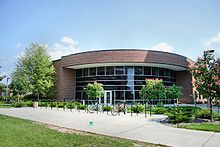| MSU Cyclotron | |
|---|---|
 The Cyclotron's location on campus | |
 | |
| General information | |
| Type | Cyclotron |
| Architectural style | International Style |
| Location | Science area Michigan State University |
| Completed | 1963 (K500) |
| Dimensions | |
| Other dimensions | 2 cyclotrons |
| Design and construction | |
| Architect(s) | Black (1963) et al. |
| Website | |
| NSCL Homepage | |
The National Superconducting Cyclotron Laboratory (NSCL), located on the campus of Michigan State University was a rare isotope research facility in the United States. [1] Established in 1963, the cyclotron laboratory has been succeeded by the Facility for Rare Isotope Beams, a linear accelerator providing beam to the same detector halls.
Contents
NSCL was the nation's largest nuclear science facility on a university campus. [2] Funded primarily by the National Science Foundation and MSU, the NSCL operated two superconducting cyclotrons. The lab's scientists investigated the properties of rare isotopes and nuclear reactions. In nature, these reactions would take place in stars and exploding stellar environments such as novae and supernovae. The K1200 cyclotron was the highest-energy continuous beam accelerator in the world (as compared to synchrotrons such as the Large Hadron Collider which provide beam in "cycles"). [3]
The laboratory's primary goal was to understand the properties of atomic nuclei. Atomic nuclei are ten thousand times smaller than the atoms they reside in, but they contain nearly all the atom's mass (more than 99.9 percent). [2] Most of the atomic nuclei found on earth are stable, but there are many unstable and rare isotopes that exist in the universe, sometimes only for a fleeting moment in conditions of high pressure or temperature. The NSCL made and studied atomic nuclei that could not be found on earth. Rare isotope research is essential for understanding how the elements—and ultimately the universe—were formed.
The nuclear physics graduate program at MSU was ranked best in America by the 2018 Best Grad Schools index published by U.S. News & World Report. [4]
